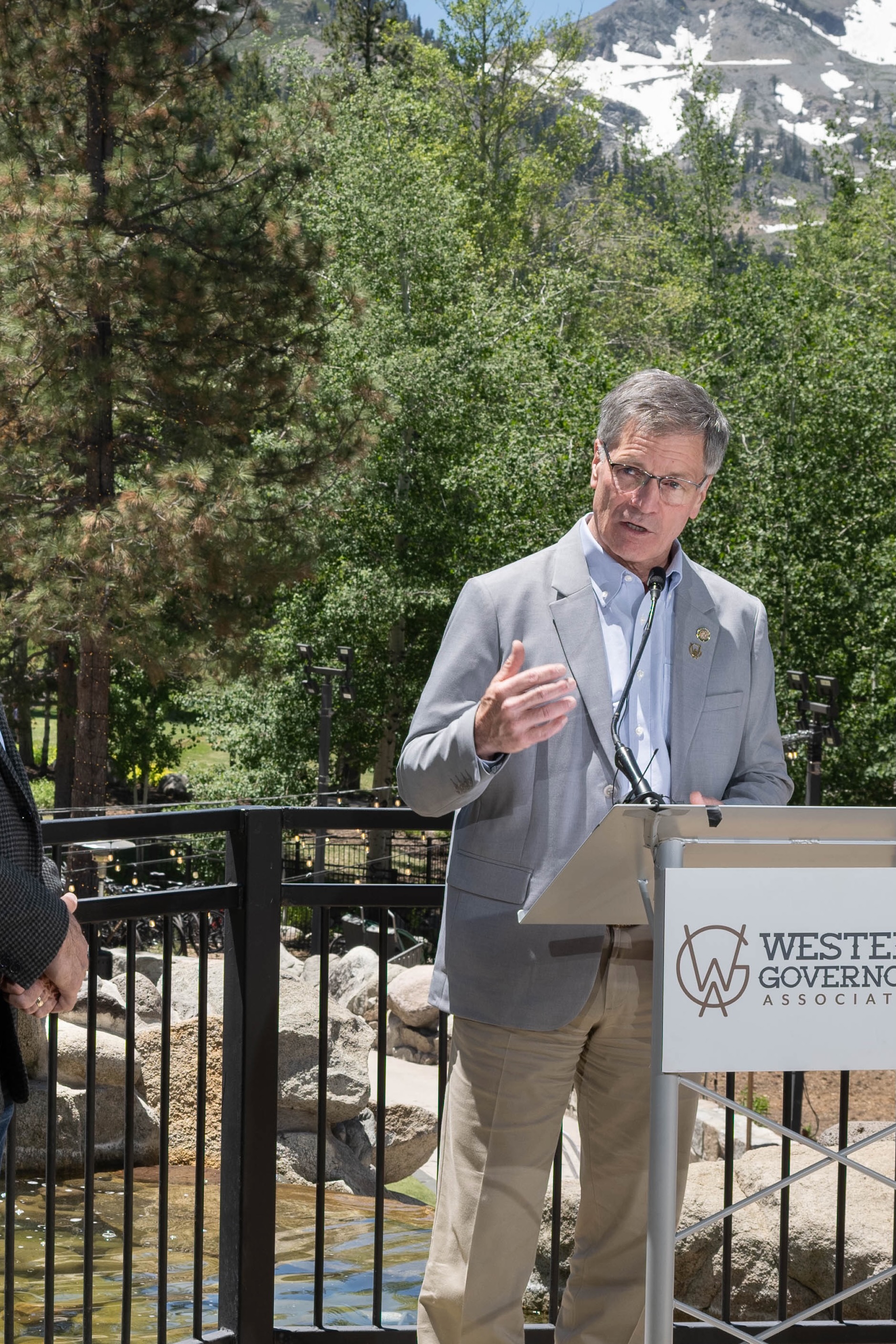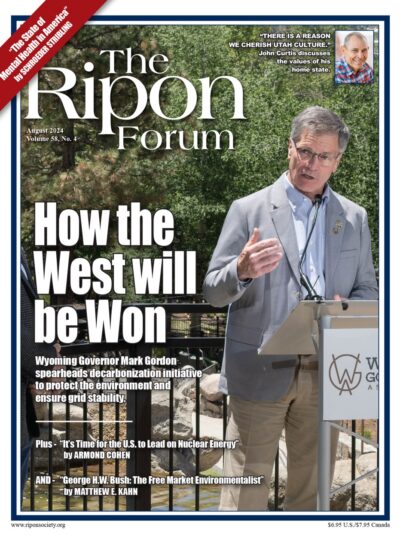
Carbon capture is a hot topic of late, generating speculation, political debate, and coffee shop rumors across the nation.
Its proponents tout the potential to prevent and possibly remove gigatons of carbon dioxide from the atmosphere, decarbonize essential industries, and create new economic opportunities. Its opponents say the technology is unproven, expensive, hampers industrial development, and even prevents the growth of plants.
As Chair of the Western Governors’ Association (WGA), a bipartisan policy organization representing 20 western states and territories, I launched an initiative entitled “Decarbonizing the West” to have an honest conversation about the social, environmental, and economic costs and potential benefits of various carbon capture, utilization, and storage (CCUS) practices.
I believe an open, honest and thorough dialogue about these strategies is essential. Such discussions could lead to local, state and federal governments promoting environmentally sound, economically viable, and tenable paths to lower CO2 emissions while ensuring we continue to have sustainable, dispatchable energy for our nation.
Importantly, this initiative focused on ways to innovate and build, not cut back or suppress, core industries. When the narrative around decarbonization takes on a tone of vitriol — no matter the technology or industry it’s directed at — collaboration between the private sector and government to reduce CO2 and methane while maintaining a vibrant energy economy that includes fossil fuels is muddied. This initiative underscores the fact that oil and gas engineers, coal miners, agricultural producers, and industrial manufacturers are critical to meeting this challenge and continuing to lead American energy production into the future.
This initiative underscores the fact that oil and gas engineers, coal miners, agricultural producers, and industrial manufacturers are critical to meeting this challenge and continuing to lead American energy production into the future.
Leading in the energy sector does not include destroying our nation’s most productive power systems. But it also doesn’t ignore environmental and market realities that consumers across the world are seeking lower CO2 energy and products.
With this in mind, my year-long initiative convened stakeholders across the political spectrum and from around the world. It included four workshops hosted by a bipartisan slate of Governors (Jared Polis of Colorado, Brad Little of Idaho, Tina Kotek of Oregon, and me). It also included two webinars with industry experts from WSP (a multinational engineering and design firm), the North Dakota Industrial Commission, the University of Wyoming’s School of Energy Resources, and the U.S. Department of Energy’s Loans Program Office.
These convenings served as a perfect forum for state leaders to meet with federal representatives, industry experts, academics, nongovernmental organizations, and local stakeholders to share best practices and exchange critical information about emerging carbon management strategies.
Participants included the U.S. Departments of Energy and Agriculture, the Bureau of Land Management, the Pacific Northwest National Laboratory, Lawrence Livermore National Laboratory, Idaho National Laboratory, The University of Wyoming, Tri-State Generation, Basin Electric Power Cooperative, Net Power, Carbon Capture Inc., Kawasaki Heavy Industries, GTI Energy, The Bipartisan Policy Center, The Walton Family Foundation, Pew Charitable Trusts, The Nature Conservancy, JP Morgan, Google, and many others.
The findings from the initiative were published in the Decarbonizing the West initiative report, which was released in June. The report includes recommendations for how CCUS practices can be advanced without compromising our standard of living. Some of the more notable proposals focus on the need to increase federal incentives and reduce regulatory burdens for the full suite of carbon dioxide removal options.
Leading in the energy sector does not include destroying our nation’s most productive power systems. But it also doesn’t ignore environmental and market realities that consumers across the world are seeking lower CO2 energy and products.
Ultimately, I believe this report will serve as a roadmap to position the United States — and the West in particular — at the forefront of innovation for years to come. If implemented, the report’s recommendations can provide consistency, soundness, confidence, and opportunities for business investment today and in the future.
Make no mistake — as we heard time and again throughout the initiative – the potential for CCUS is not a futuristic pipe dream. The diversity of our western states presents economic opportunities as we collectively work toward lowering emissions and building a reliable, dispatchable energy grid.
CCUS technology can create new economic sectors to bolster the rural coal communities that have generated the nation’s energy for decades. It can convert carbon emissions into a base material for value-added products. It can supply a reliable source of CO2 for enhanced oil recovery. It can supply agricultural producers and land managers with new revenue streams. Best of all, these technologies can be designed and manufactured right here in the U.S. and exported around the world.
Just look at what we’ve been able to do in Wyoming.
At the Integrated Test Center in Gillette, Wyoming, scientists from UCLA successfully injected carbon dioxide emissions from a coal-fired power plant into concrete. This process not only eliminates emissions from the power plant, but also reduces the significant carbon footprint of developing concrete by up to 100 percent. The concrete blocks created using this technology cost no more to produce than traditional concrete and are now being used in the construction of several municipal projects across the state of Alabama.
Since opening in 1986, Exxon Mobil’s carbon capture facility at the Shute Creek Treating Facility in LaBarge, Wyoming has captured more carbon emissions than any facility in the world (over its lifetime, the Institute for Energy Economics and Financial Analysis estimates that Shute Creek has captured up to 120 million metric tons of CO2).
Originally developed to produce natural gas and helium — which is an essential component for health care equipment and high tech products including fiber optics, semiconductors and materials for space travel — the facility captures the carbon emissions created from the development of renewable natural gas and helium and sells it for enhanced oil recovery. As part of its 2030 emission reduction plans, ExxonMobil announced a $400 million expansion of the facility, which will increase its capacity to capture carbon by 1.2 million metric tons of CO2 each year for a total of roughly 8 million metric tons of CO2.
Carbon capture, utilization, and storage technology can create new economic sectors to bolster the rural coal communities that have generated the nation’s energy for decades.
Using technology developed at the University of Wyoming’s Center for Biogenic Natural Gas Research, Cowboy Clean Fuels is developing a project in Johnson County, Wyoming that injects feed-grade sugar beet byproducts into non-producing coal bed methane wells that naturally convert these byproducts into CO2 and methane. The CO2 is permanently stored underground while the methane is used for the development of low-carbon renewable natural gas (RNG), opening the door for the sale of both carbon dioxide removal credits and carbon-negative RNG.
Not only will these projects collectively absorb millions of metric tons of CO2 each year, but they will also provide an opportunity to decarbonize hard-to-abate industries, create new jobs in these communities, and increase state tax revenues.
Projects like these are positioning Wyoming as a leader in developing CO2 as a marketable product to support the existing energy sector, rather than suppressing it.
In this time of political division, the Decarbonizing the West Initiative reflects the long-standing, bipartisan ethos of WGA. The process allowed participants — again, representing 20 member states and territories — to develop common sense policy recommendations that will enable the continued production of necessary energy, promote protection of our environment and sustainability of the many rural communities that generate the nation’s power.
For more information about CCUS technologies and policy recommendations to advance the industry, read the Decarbonizing the West initiative report at westgov.org/reports/article/decarbonizing-the-west-initiative-report.
Mark Gordon is the 33rd Governor of Wyoming and served as Chair of the Western Governors’ Association for the past year.




